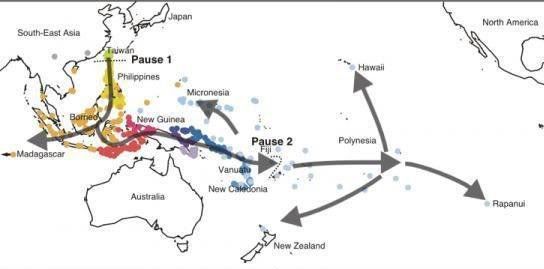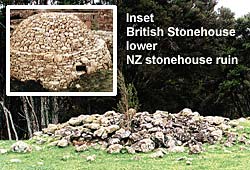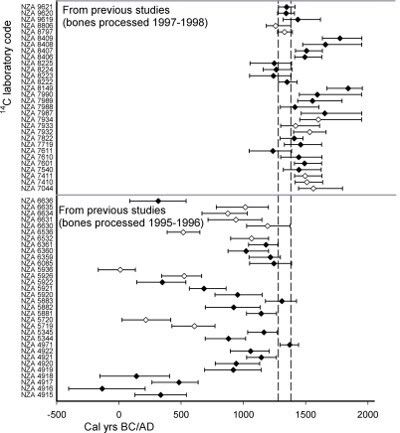Thursday, July 29, 2010
The First New Zealanders and their rats
Crispin Jago has made a very cool thing, a periodic table of irrational nonsense. Rolling my eyes over the groups, wondering how people can believe some of these things, made me think about New Zealand's unique ecosystem of kooky ideas. We don't have to suffer creationists in any organised sense and I don't think anyone is too into ear candelling, but those TV psychics have found themselves a niche to exploit and most people seem think chiropratric and homeopathy are normal parts of medicine. Then I was reminded about our very own, home grown cranks. There are people who believe that New Zealand was settled by Celts several hundred years before it was discovered by the ancestors of modern Māori. It probably goes without saying that these people are nuts, but the idea of a pre-Māori civilization in New Zealand is one of our culture's enduring myths. It's worth talking about why people who are serious about studying our country's prehistory have discarded it.
People coming to this question for the first time my want a little bit of background. The settlement of the Pacific is one of the most interesting stories in our species' history. I did the field work for my PhD (on landsnails, and not people) in the Cook Islands and you get a feel for the enormity of that achievement when you travel around that group. To fly from one island to another you walk out across the tarmac and meet your pilot, who is almost invariably sitting on the steps to his 12 seater plane, reading the paper through massive aviator glasses. Once you're safetly stowed you get your safety briefing ("it's gonna be pretty fine all the way, should be a good flight") and you take off. The pilots don't close the door to the cockpit, so you can see out the windscreen, but all you see is ocean and sky. You can fly for an hour without seeing land in front of you or out your window. Then an island looms. A few minutes later you land, and, even among the Cook Islands, you're in a new culture. The Polynesian people who discovered and settled these tiny islands separated by such vast distances were master navigators. Without metal tools or written records, let alone maps and compasses, they very deliberately settled islands (taking livestock and crops with them), maintained trading relationships between island groups and almost certainly made it to South America (very likely beating Columbus in the process).

Schematic of the settlement of the Pacfic (this one is taken from a study of the evolution of Austronesian languages)
The "mainstream" view on the settlement of New Zealand fits nicely into what's known about the settlement of the Pacific. There is good evidence that the bulk of Polynesia was settled in a stepwise fashion, moving west to east with the prevailing winds. Eastern Polynesia was settled by about 800 AD. The far reaches reaches of Polynesian - Hawai'i, Rapanui and New Zealand would require a different pattern of migration (upwind, or over vast distances) and remained, with Antartica, as the last uninhabited lands on earth for hundreds of years.
The first evidence for humanity in the New Zealand archeological record comes from the Wairau bar, where artifacts similar to those from contemporaneous sites in the Society Islands and the Southern Cooks have been dated to about 1280 AD. At the same time the pollen record shows New Zealand's first wide scale deforestation, trees being replaced by bracken, scrub and charcoal. A few hundred years later the much sparser record of sub-fossil animals shows its first mega-faunal extinctions. Combined with evidence for "sattelite" settlements in the Kermadec islands (on the edge of the tropical Pacfic) you have exactly the pattern of evidence you'd expect to see with the settlement of islands as remote as Te Wai Pounamu and Te Ika a Māui - settlement as an extension of an ongoing process with clear evidence for human impacts starting from a date that makes sense in that framework
Compare that with the Celtic NZ people. The idea of Celts arriving in New Zealand without leaving any real evidence of their presence anywhere else outside of Europe hardly needs talking about. When we look within New Zealand, almost all the evidence supposed to support a pre-Maori celtic civilization amounts to big rocks that form, if you just imagine they used to be arranged slightly differently, a giant surveying network. Or astronomical observatories. Proponents of the Celtic NZ hypothesis spend very little time trying to find any evidence for the populations that must have lived, died, eaten, built, dug, farmed, and buried their dead in New Zealand to support these mad priests' plans to move megaliths across the country. And when they do the results are less are less than convincing

By all accounts they treat the historical method with about as much respect as the scientific one, so academics don't take them very seriously. In fact, you'd think these claims are so kooky that there was really no need to rebut them. Sadly, the Celtic NZ people seem to have convinced at least a few people that they are on to something. I'm sure part of the reason for that is New Zealanders were once taught that the ancestors of modern Māori did meet another people when they came to New Zealand.Up untill about the 1960s school textbooks said the Moriori were a Melanesian people that were driven off the New Zealand mainland by Māori, with a few survivors taking refuge on the Chatham Islands (called Rekohu in their language). That idea had been rejected by every scholar who's addressed it since the 1920s because it's clear that the Moriori descended from mainland Māori and the unique aspects of their culture were acquired during their subsequent isolation. Part of the reason the Moriori myth came about in the first place is that it fitted into a Victorian narritive view of history - a chain of never ending progress It was only right that Moriori hunter-gatherers were replaced my the adventurous and noble Māori, just as the advanced British settlers would in turn assimilate the Māori. We might have given up that story, but the Moriori myth is still tied to politics in New Zealand. For people who think the New Zealand government shouldn't make reparations for its breaches of the Treaty of Waitangi the idea that Maori themselves were once colonisers looks like a get out of jail free card. Russell Brown quoted one example in 2004:
Leaders and academics that hark back to the pre-European days of Maori domination of New Zealand have driven this opportunism. They appear to conveniently forget that Maori violently conquered the Moriori, the original settlers, and their claims of tangata whenua status and demands for compensation for historical grievances appear to many to be ill informed.
Archaeologists agree that humans first settled in New Zealand well over 1,000 years before the main Maori migration, which is estimated to have arrived around 1200 AD. Their evidence is based on the exhaustive forensic examination of historic plant and animal remains. They believe that the settlement of New Zealand was most likely a continuous process, a view that is certainly consistent with early settler journal accounts (from the proceedings of the Royal Society of New Zealand) which indicate that not only did Moriori precede Maori, but that when they arrived in the Chatham Islands, “they found the country in the possession of aboriginal natives called Hiti”- inhabitants of the “Flint age”, who used not stone, but “chips of obsidian as cutting implements.” There is also strong evidence of an early presence of people of Celtic and Chinese ancestry as well as Greek, French, Portuguese, Spanish and others - in addition to settlers of Polynesian descent.
Breathtaking. But perhaps the most amazing bit of that bizarre paragraph is that somewhere, deep under the layers of crazy, there is just a little science peaking through. We've already seen that archeologists don't agree that New Zealand was settled a thousand years before the Māori arrived. But there has been one little hint among the prehistoric "plant and animal remains" that humans might have got to New Zealand before the people that lived at Wairau Bar. Old Rat bones.

A Pacfic rat, image is CC 2.0 thanks to wikipedia user Tolter Alter Man
The Pacific rat (Rattus exulans or the kiore) is native to South East Asia and Melanesia, but it can be found everywhere Polynesian people visited. The kiore isn't much of a swimmer so the presence of R. exulans bones on an island is unambiguous evidence for human contact. In 1996 Richard Holdaway published the first radiocarbon dates for kiore bones in New Zealand, and they were surprising. Holdaway published dates for 18 bones and all but two of them were older that the first archeological evidence for humans (at 1280 AD) and some of them dated to around 10 AD. Quite how the presence of the Pacific rat in New Zealand in 10 AD gives support to the wild claims of people like Newman or the Celtic NZ crowd I can't imagine, but those results did fuel a genuine scientific controversy. Why were there rats in New Zealand almost a thousand years before there is any evidence for humans? At the time there were three answers; Holdaway himself argued that the bones were evidence that humans had visited New Zealand but either left immediately or failed to establish themselves, a few archeologists held that the bones were evidence the ancestors of Maori arrived in New Zealand a long time ago but didn't leave a mark until they adapted to the colder climate, and others said the dates must just be wrong.
Atholl Anderson dedicated a lot of time to testing the reliability of radiocarbon dates from kiore bones. The bones Holdaway had used to establish the antiquity of New Zealand's rats had come for so called "natural" sites, most notably laughing owl nests and caves, which offer little in the way of corroboratory evidence for the ages estimated from the rat bones. In contrast, Anderson focused on archeological sites (those associated with human habitation) which provide plenty of contemporaneous material to set the dates determined for rat bones in context. Anderson did indeed find the dates determined from rat bones often differed greatly to those determined from the contents of the same midden. They even found bones from well studied archeological sites that were estimated to be thousands of years older than the site! Clearly, there's something odd about those dates. The real smoking gun for the "old rats" hypothesis came when Anderson looked at the relationship between the age estimated for a bone and the date of the labwork done to determine that age. Almost all the bones measured before 1997 were older than that magic mark at 1280 AD, and every single bone measured at the same facility since 1997 was younger (or at least, the error bars cross that date):

Dates estimated from rats fall into two distinct groups, depending on when they were analysed. From Wilmshust et al (2008) cited below
There is no reason to think the real age of the kiore bones sampled over time will fall into two such distinct classes (it's not as if the oldest bones will be the easiest to get to) and it's easy to bias the date estimated by carbon dating by failing to prepare the bones properly (or by introducing contamination in the lab) so it looks like the surprising results Holdaway reported where actually a lab error which has since been taken care of. It's (barely) conceivable that originally published dates were right, and that the Anderson's archeological sites were biased in some particular way, but that hypothesis really doesn't make sense given what we now know about the settlement of the Pacific. It's widely accepted that Eastern Polynesian wasn't settled until about 800 AD, meaning any earlier rats in New Zealand would have had to come from visitors from the Western Pacific. That's against the main direction of settlement, but, more tellingly, genetic evidence has established that modern kiore in New Zealand come from Eastern Polynesia. Kiore also make their first mark on New Zealand's faunal record around 1300 AD, when Plactostylus landsnails with gnawed shells show up for the first time. If you want to believe rats were in New Zealand 2000 years ago you also have to believe the first bones to be carbon dated were the oldest, dates estimated from archeological bones are more unreliable than those for bones sourced from "natural" sites and that those old rats left not descendants in modern New Zealand populations and left no mark on the New Zealand faunal record until just after Polyneisian settlement of New Zealand.
You might be wondering why someone hasn't just gone back an re-analysed the bones that made for Holdaway's original surprising results. Radiocarbon dating is a destructive process and rat bones are small, so, apparently there isn't enough bone from the original samples to re-determine their age. Recently, a team from Landcare Research and lead by Janet Wilmshurst did the next best thing, and went back to sites that gave up the apparently old rat bones and re-excavated them. I'm sure you can guess what they found, none of the bones had a pre-1280 AD date. But they didn't just look at rat bones. The subfossil record of plants is almost always more finely grained than animal records. Every year plants put out millions of seeds and pollen grains, some of which are recorded in pits and lake beds and soil horizons. The Landcare team took advantage of this high resolution record to look for the first appearance of distinctively rat-gnawed seeds, and they found them after 1280 AD, but earlier than the oldest rat bones. Importantly, some of the deposits with relatively old rat-gnawed seeds contain much older seeds, with no evidence of rats. The team plans to go on an use this high-resolution record to establish the dates of settlement for other Pacfic islands.
The sort of people who think the presence of the Pacific rat in New Zealand would be evidence for a pre-Maori Celtic population aren't likely to let evidence get in the way of their stories. They already think the entire New Zealand acadame is par of a grand conspiracty (they've apparently never tried to organise a meeting between three academics let alone pull of a conspiracy among them...). But hopefully the long story of the first New Zealanders and their rats, only summarised above, and the kinds of evidence scientists use to test their ideas will help to make it clear what such "alternative" archeologists lose when they turn their backs on established methods
This post got way longer than I thouhgt it would, and I'm emdebted to a lot of excellent source on the web to get me up to speed on the subject.
Scott Hamilton and Matthew Dentith have written extensively about the Celtic NZ crowd and Te Ara has a nice article on historical ideas on of the orign of Māori (check out the galleries in particular to get an idea of European attitudes at different times)
The orignal paper with the old dates is:
- Holdaway, R. (1996). Arrival of rats in New Zealand Nature, 384 (6606), 225-226 DOI: 10.1038/
- Anderson, A (2000). Differential reliability of 14C AMS ages of Rattus exulans bone gelatin in south Pacific prehistory Journal of the Royal Society of New Zealand, 30 (3)
- Wilmshurst, J., Anderson, A., Higham, T., & Worthy, T. (2008). Dating the late prehistoric dispersal of Polynesians to New Zealand using the commensal Pacific rat Proceedings of the National Academy of Sciences, 105 (22), 7676-7680 DOI: 10.1073/pnas.0801507105
Labels: Anthropology, Cook Islands, history of science, Maori, Pacific, Polynesia, research blogging, sci-blogs, science
6 Comments:
Dunedin pharmacies still sell ear candles, as far as I'm aware, although I know several people who have complained about this - candling is dangerous.
DG,
OMFG, I either need to come down from the ivory tower more often or never again. That's terrible, if it's really widespread that would be a good skeptical campaign.
I presume you are particularly keen on including the role of diet in the mis-dating. At the time I wrote this I passed a copy on the Richard Holdaway, who didn't feel the need to say anything about it.




